[Click here to read the follow-up to this post.]
We radio enthusiasts are a nostalgic bunch. Let’s just admit that and get it out of the way.
I’ve always found it difficult to let go of vintage radios, but over the past three years I have. I used to have well over a dozen boat anchors (heavy metal tube/valve radios) here at SWLing Post HQ. Today, I have three: my Scott Marine Model SLR-M, Signal Corps BC-348Q and Minerva Tropic Master (the Minerva being the lightweight of the bunch).
I found solace in donating some of my radios to museums and selling or giving them to friends who appreciate and will maintain them.
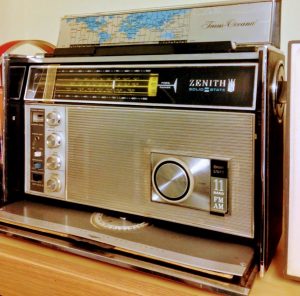
This radio played no small part in my life.
Outside of vintage radios, I have much less trouble selling or giving away my stuff; especially consumer electronics. I have very little attachment to those. I’ve never fallen in love with a phone, laptop, desktop or desktop PC.
Save my first personal computer, the TRS-80 Tandy Color Computer 2 (a.k.a. Coco 2).
I always tell people the two things from my childhood that had the most impact on my life were my Zenith Transoceanic shortwave radio and my Tandy Color Computer 2.
The shortwave radio kindled my interest in world news, languages, culture, music and traveling. And…well, it eventually lead to a lifelong passion in radio and, consequently, the SWLing Post.
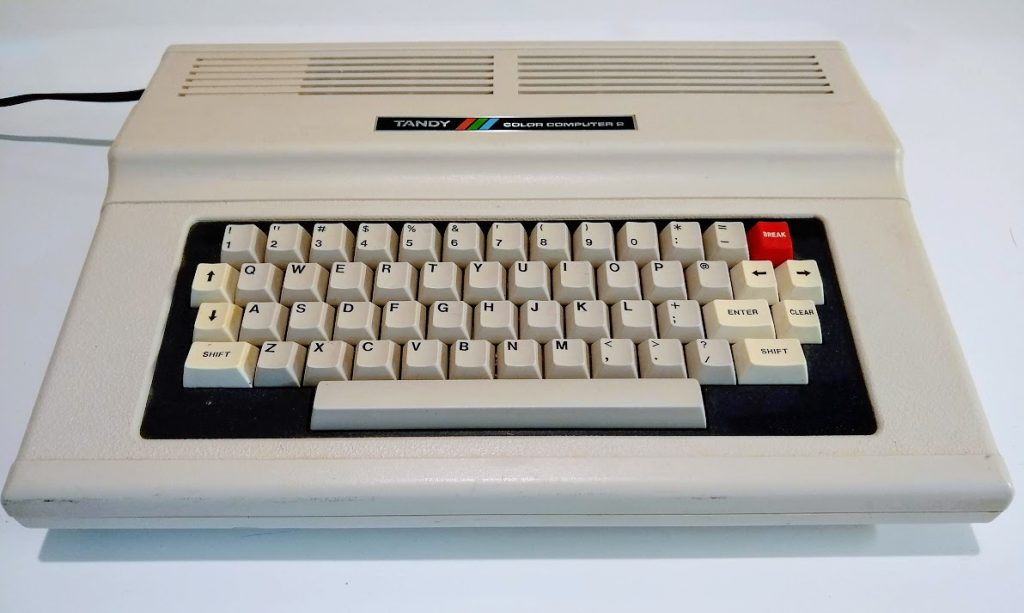 Incidentally, The CoCo 2 taught me a skill that would also change my life.
Incidentally, The CoCo 2 taught me a skill that would also change my life.
Without knowing it at the time, the CoCo 2 taught me programming.
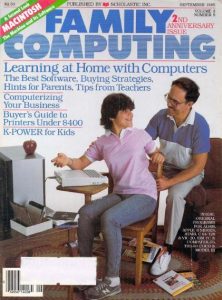 I couldn’t afford game cartridges as a kid, so I programmed my own simple CoCo 2 games with Family Computing magazine (remember them–?).
I couldn’t afford game cartridges as a kid, so I programmed my own simple CoCo 2 games with Family Computing magazine (remember them–?).
Each month, Family Computing featured a number of programs and games you could input yourself. It was brilliant! My best friend, Junior, had a subscription to the magazine and would bring each issue over to the house and we’d type in lines and lines of code with the ultimate goal of playing a game or making our computers do something new.
Of course, 11 year old kids aren’t the best typists, so we’d always had to debug the code, following the error trail before the program would work. We’d also modify the code afterwards to see how it would change the program–it was amazing fun!
Keep in mind my CoCo 2 only had a whopping 16K of memory and all of it was volatile. Each time I’d turn the unit off, I’d lose everything I’d typed in. That is, until I could afford a tape recorder to save and load my programs (I still have it around here somewhere…).
 Fast forward a dozen or so years…
Fast forward a dozen or so years…
In my first “real” job out of college, my manager noticed quickly that I could program and modify local copies of company databases so that my applications were more efficient and tailored to my job. The database system used a formula language that followed the same logic as the CoCo2’s Basic, so was pretty simple to pick up once I sorted out the commands and syntax. To be clear, I wasn’t hired for programming or IT skills, in fact it never came up in the interview as I was being hired for my French language skills.
Other than the Coco 2, I had no IT or computer studies in any formal setting–not in high school and not in college. Within three years at the company, I was promoted and sent to Europe to tie together and develop a number of database systems for the company’s various international sites. It was an dynamic, fun and rewarding career.
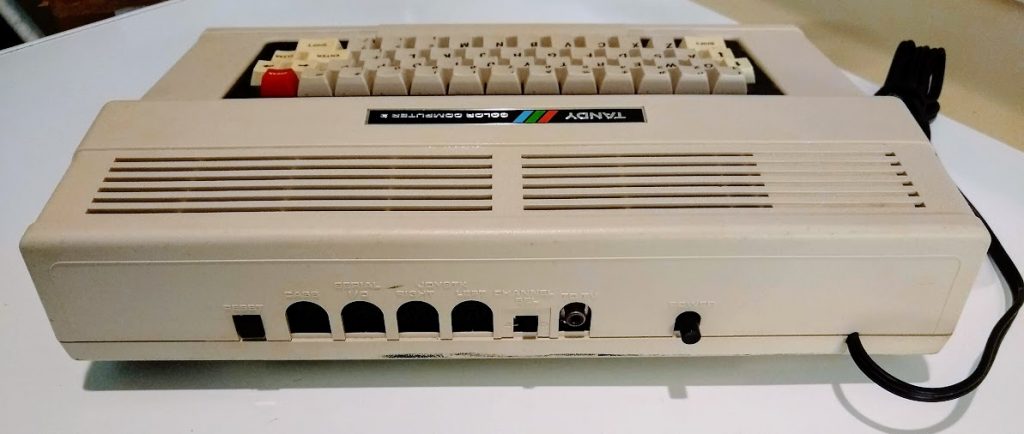 None of that would have ever happened had it not been for the CoCo 2.
None of that would have ever happened had it not been for the CoCo 2.
So why am I considering selling the Coco 2?
Frankly, I never use it and don’t even have the adapter to plug it into any of my modern monitors. I’ve only been keeping it for sentimental reasons. I’ve been trying to let go of things I don’t use and this would certainly fall into this category. I doubt it’s worth a lot…perhaps $20-$40? I’m not really sure.
Then again, I almost gave my Zenith Transoceanic away once and am very thankful now that I didn’t.
As I was about to put the CoCo 2 on eBay, I pressed pause and wrote this post instead.
What do you think? Should I sell it or keep it? What would you do?
Also, are there any other early PC enthusiasts out there? Please share your thoughts! While this isn’t a PC blog, I image this might be a common thread among us radio enthusiasts. Please comment!
And for fun, here’s a little poll to help sway me:
Do you enjoy the SWLing Post?
Please consider supporting us via Patreon or our Coffee Fund!
Your support makes articles like this one possible. Thank you!

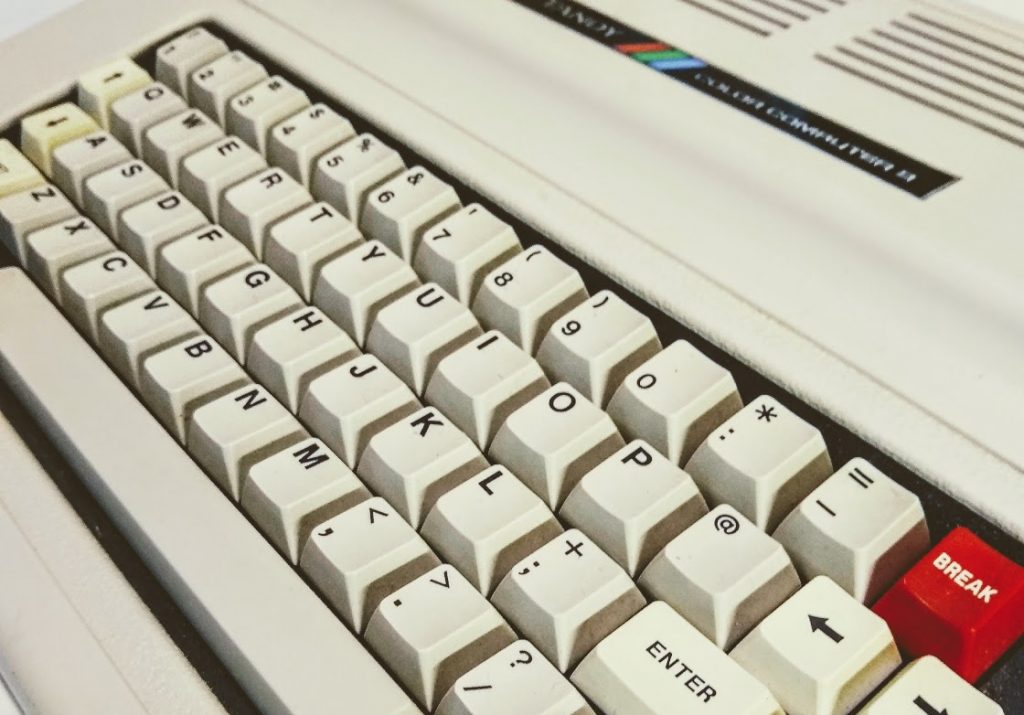

im late here, but my opinion is if you sell, i think $40 ish is average but seeing thats not that much i would just keep it, also all you need for an adapter is a F-Type Male to RCA Female Adapter and use a tv.
This article brought back such nostalgia for me. I remember as a kid copying these programs in BASIC from the magazines, then programming my own, albeit rather simple. I couldn’t begin to guess how many hours I spent on this machine. I would keep for sentimental reasons alone, personally.
Tough call. These days you can emulate the CoCo 1, 2, or 3 with any of several emulators, and there are even FPGA versions.
On the other hand, in these days of FPGAs, Arduinos, and the like, an amazing amount of new hardware is being made for or interfaced to the CoCo, be it 1, 2, 3, or even the Dragon (a Welsh CoCo-like 6809 computer). There are *two* CoCo podcasts (CoCo Crew and CoCo Talk Live, the former monthly and the latter weekly).
You should take a look at the Facebook Color Computer and Color Computer OS-9 groups.
Thomas, keep it, keep it, keep it 🙂 !
Just ensure to have an old TV around; that said, that “old horse” may still allow you to have quite some fun; just have a look here http://www.trs-80.org/color-computer-1/ for a start (and there are a number of other sites dedicated to the “CoCo” :D)
then you may, for example, put together some code to (e.g.) decode RTTY/CW 🙂 or, as I did years and years ago for a friend, with a bit of soldering smoke and some code you may even use the available interfaces and I/O ports to put together a program to track satellites 🙂 ! You’ll need some circuitry to control two rotators (azimuth/zenith), an adapter to receive the rotators position and some code which, given the orbital data will adjust the antenna(s) aiming; then if you want, you may even add some circuit/code to send the received signal level to the computer and some code which could use it to better adjust the aiming 🙂
Again, keep it !
As for other sites …
http://www.cocopedia.com/wiki/index.php/Main_Page
I suspect you’ll like it 😀 !
OMG !
https://nitros9.sourceforge.io/wiki/index.php/Main_Page
and
http://cloud9tech.com/
now tell me, are you still thinking to give away your CoCo II ?
Ok, now I’ll stop spamming 😀 !
Noted!
Keep It! I wish I still had my first programmable calc, the TI-58C. It was the first thing I could program on my budget, used it for years till I lost it. I wish I still had it to use. Get your cables and stuff, it’s dirt cheap on ebay. And Have Fun With It!
Thanks Timothy!
There’s only a tiny chance you’ll regret keeping it but a big one selling it!
I too remember me and my brother spending many nights typing BASIC listings off magazines back then, 2 out of 3 times the same debugging was needed, sometimes the programs only ran a month later, when the magazine published the corrections for the previous months’ listings… 🙂
We had a great time anyway, and we got a sense of witnessing the revolution these crude little “home computers” would set off, then we usually had breakfast and went to sleep. Yes, it turned our world upside down and we loved it.
Thinking of that, I wouldn’t have a real purpose for any of these computers either, other than bringing up those memories, but for that a pic of that (or your) computer would suffice as this comment proves.
Very good point, 13dka: “There’s only a tiny chance you’ll regret keeping it but a big one selling it!” In the end, I agree!
I had my CoCo III on a shelf over my desk, I used some ribbon cable to allow the keyboard to sit on the desk. I’d done the same thing with my previous CoCo 2, though there I’d wired up a surplus keyboard, not the one from Radio Shack, to sit on the desk.
When I moved to a Mac Plus in late 1993, not that big an improvement since the GUI used up the better resources, I just left the CoCo on the shelf. I could move a tv set there and turn it on a quarter century later, though who knows if it would work without some attention.
I have all my early computers, KIM-1 from 1979, OSI Superboard II from 1981, CoCo II with the flat keys from 1984, Radio Shack Model 100 from 1985, CoCo III from the first year, I think 1987. I had a third party floppy drive and controller for the CoCo in 1984.
Things moved fast, so the computers changed fast, but each was unique, unlike after the IBM PC took over. So each is a collector’s item, especially because they were mine. There were !ots of home computers in 1979, except dwarfed by what came later, really a few iterations. I didn’t keep the Mac Plus, or t he computers that followed, though I do have some from the period which I bought later, very cheap but I’ve never used them beyond turning on.
I have spare CoCo 2s and 3s, bought cheap after the fact, just in case. But I saw few at garage or rummage sales, and not since 1995 or so. The ones I did see were a!one, no accessories, not even cartridges.
It’s easier to keep something at this point than try to get a replacement later. CoCos were probably popular enough that they won’t be really expensive, but you already bought yours, a new one would cost more.
Michael
Agreed! Thank you.
As someone who is downsizing radios myself, I still have my limits. Keep the computer, mainly because it is a connection, no, a very important connection, to your past. As I have grown older I have come to realize the significance of being connected to the things which touch your soul, and therefore I keep watch over those things. Just my 2 cents worth. Cheers old friend!
You know me all to well, my friend!
Have you gone totally bonkers Thomas? KEEP IT!!!
Thanks for the wake up call, Mark! You know me well–I appreciate the splash of cold water in the face!
Hi Thomas
I have similar nostalgic feelings about my Commodore Vic-20, which I sold years ago. Is there a museum that would take your computer? Perhaps with your story?
I thought about this, but didn’t really know of one good museum. It was a backup plan, though.
Thomas,
Nice post. I was much like yourself it seems. I had a subscription to Family Computing and for the first year or so typed in countless lines of BASIC into my Commodore 64 and always worried about the power going out during summer thunderstorms – until I finally got a disk drive for storage the following Christmas. Good times…
Retro computing is a ton of fun and you’d be surprised at the size of the community that still exists surrounding your little CoCo2. I say you fire it up… and relive the old days – even more fun introduce a kid to the old machine.
interesting video podcast devoted to the CoCo : https://www.youtube.com/watch?v=Of_t4IGHRMk
I never have a CoCo but the discussions on some of the harware hacking that they are really cool and impressive.
Anyhow – before you send it off. Hook it up, check out some of the fansites and facebook pages, and see if it rekindles some of the old “computing fun” from when in your youth.
Thanks,
Sean
I had no idea there was even a recent podcast about the CoCo! Thanks for sharing your memories and advice. Family Computing was the BEST!
i’m thinking that the coco2 would make an excellent RTTY decoder!! KEEP IT!!!
Noted!
Hi Thomas,
Could you write a program for the CoCo 2 to do some digital radio modes or somehow hook it up to an SDR? Probably not enough memory .
I guess I’m just trying to be an enabler!
Yes indeed, Justin, you are being an enabler! But I guess that’s what the doctor ordered in this case! 🙂
My experience with personal computing started with Radio Shack’s Color Computer in the early 1980s so I know the MC6809E microprocessor along with Microware’s OS-9 fairly well. I still use much of the software in an emulator. Those days were unreal with the rapid pace of development. Nearly every device we use today had its genesis in the 1970s through 1980s.
It was an amazing time period in personal computing!
I’ll take it. I’ll give it a good home next to my TRS-80 Model 1! I could even trade you an old Nordmende tube radio with shortwave for it if you want.
Unfair, Dan! 🙂 A Normende tube radio in trade and my CoCo 2 gets a good home with good friends?
That was a very tempting offer, but I have decided to keep the old girl.
You need to bring the Normende to the next SWL Fest! Those are great radios.
73!
I had a Timex Sinclair when they first came out…. It is probably the reason i really give a rat’s patoot about computers… However, it wasnt your blog about getting rid of the co-co that made my heart start… it was the mention of GIVING AWAY some of your equipment in the past that got my fingers pushing these computer keys… Short wave receivers are hard enough to obtain here in the PI… let alone antique ones…. now, say, if you were to donate one of your machines to the cause you would make an old man very happy… and Id promise to be your best friend for life – especially if the radio works well… HIHI
Ha ha ha!!!
Many of the radios I’ve given away have been to people I’ve met in person (local friends or friends I meet at swapfests/hamfests). If any kid shows a genuine interest in shortwave radio, I end of giving them one of my good portables.
I do sell gear, too, mainly to help fund buying review units, upgrading my shack, and to pay for radio-related travel (conventions, etc.).
I had a friend that got an early Timex Sinclair. It was the first personal computer I ever saw in use and he was quite a prodigy, creating his own programs from scratch. The only thing that ever left me scratching my head was the design choice of Timex to use a membrane keyboard on many of the models! 🙂
Thanks!